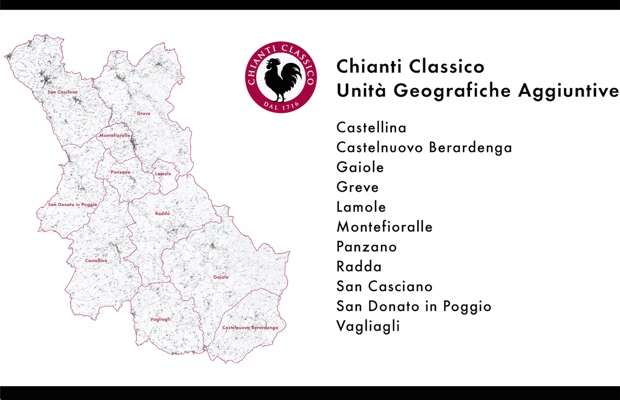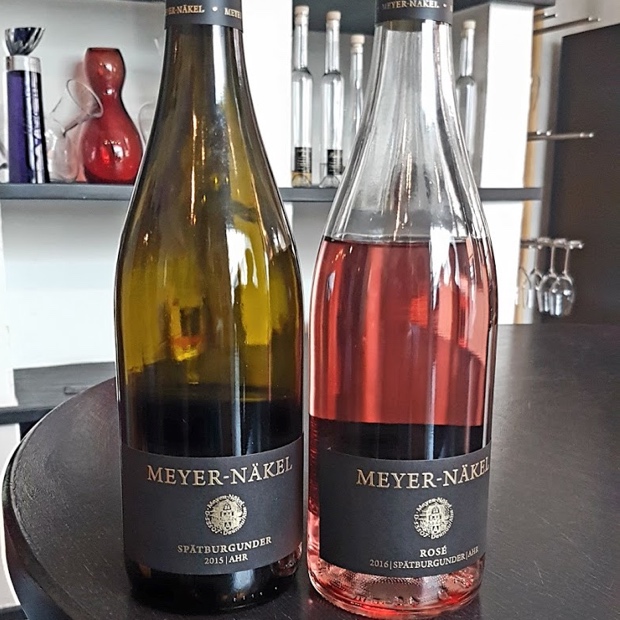In a press release issued one week ago today the Consorzio Vino Chianti Classico made a significant and potentially profound announcement: The Chianti Classico UGA project is now under way. The Assembly of the Chianti Classico Wine Consortium has confirmed that the Gallo Nero‘s (Black Rooster) Additional Geographical Units (Ùnita Geografiche Aggiuntive or UGA) plan has been approved by a very large majority. “A project to modify the production regulations of the historic appellation, which includes two important innovations. In order to show the name of the village on the label.”
These last several years have seen the rise of Associazione Viticoltori or Vignaioli in zonazione, places of interest where microclimates and shared geologies bring land and producers together. Up until 2019 there were nine communes and then eight, but their significance was measured in geographic terms. Going forward there will be eleven zones with the ability to label using a menzione (mention) as the geographic marker that is aggiunta (added) to the primary appellation. Back in 2018 I asked these two questions. “Will 2019 usher in a new era of Chianti Classico bottles noted by villages and crus on the labels? Will the Gran Selezione category seek 100 per cent sangiovese status?”
Related – Chianti Classico’s Canadian dream
So yes, more than anything else this new sub-dividing of the territory will allow producers to list their sub-zone of origin on the front label of their Chianti Classico wines. In addition to the UGA, going forward the new regulations for the Gran Selezione category at the top of the Chianti Classico pyramid will be (a minimum) 90 per cent sangiovese with support by only native grapes. Current rules for Chianti Classico in all three appellative levels; Vintage (Annata), Riserva and Gran Selezione draw on the same ampelographic base: 80-100 per cent sangiovese and up to a maximum of 20 per cent of authorized native and/or international red grapes. According to the Consorzio “the exclusive use of native local grape varieties has been approved as complementary to sangiovese, since they are more expressive and representative of the production zone and of traditional Chianti wine-growing.”
Related – Chianti Classico: Nine communes deep
When asked when the new regulations will come into effect, the Consorzio’s Silvia Fiorentini had this to say. “We expect to be able to use the UGAs on the label next year, hopefully, but we cannot say yet which will be the first new vintage to carry the UGA names on the bottle. 2020 and 2019 could carry the UGA names if a winery can demonstrate the origin of the wine through the cellar register. The 90 per cent sangiovese and the prohibition of using international varieties will become compulsory only from the fifth year after the approval of the new production by the qualified authorities (as in the ministry of agriculture). This is meant for the few estates that cannot comply with the new ampelographic base and need to replant vineyards.”
Ùnita Geograpiche Agguintive has been many years in the making for a territory with many significant sub-zones, micro-places with uniquely diverse soils and of particular micro-climates. They are the frazioni, collective growing sites often associated with and carrying the same name as a specific village, while other UGAs may refer to the commune in which they are located. The new Chianti Classico map covers 11 total UGAs; Castellina, Castelnuovo Berardenga, Gaiole, Greve, Lamole, Montefioralle, Panzano, Radda, San Casciano, San Donato in Poggio and Vagliali. The latter is the former western “butterfly wing” of the large Castelnuovo Berardenga commune; Lamole, Montefioralle and Panzano are each a uniquely situated frazione within Greve; San Donato in Poggio is a frazione and village within the commune of Barberino Tavarnelle, formerly the two communes (before 2019) of Barberino Val d’Elsa and Tavarnelle Val di Pesa. In the new UGA it will also include the area of Poggibonsi.
Related – Grande, Chianti Classico
Just eight years after the Gran Selezione were first introduced in 2013 this development begins a new chapter and movement forward. Gran Selezione is now produced by 154 wineries for a total of 182 labels and represents about 6 per cent of the entire production of Chianti Classico. While it has always been the idea and wish of Consorzio President Giovanni Manetti to establish the Gran Selezione as 100 per cent sangiovese, this first step “compromise” effects the move towards that probability. The change eliminates the usage of international grapes like merlot and cabernet sauvignon from the GS, something many producers had already begun to do. In conjunction with the UGA breakdown it also sets up greater potential for having the top wines become those drawn form a single-vineyard, or at the very least wines produced with specific grapes identified by an additional geographical denomination on the label. While for now the new UGA designations only apply to the Gran Selezione category, ultimately speaking this will help the consumer drill down and further understand the notion of terroir (or acclimazione sottosuolo and genius loci) in Chianti Classico’s top tier wines. Just one step but it sets the region up for a long term plan where all of its DOCG wines will carry the promise of additional geographical notations on their labels.
Related – Chianti Classico is the future
“The decisions are based on such criteria as oenological recognizability, historical authenticity, renown and significance in terms of volumes produced. The intent of the UGA to represent the excellence of the territory, thus competing, in a more incisive way, with the greatest wines in the world.”
“The watchword is to continue along the path of enhancing the distinctive characteristics of Chianti Classico,” notes the Consorzio. “A path that, in recent years, has brought the Black Rooster appellation ever higher in the international rankings of quality wines, increasing its fame, prestige and popularity on tables all over the world. The project, made possible by a concentrated effort by the Board of Directors over a number of years, responds to the need, arising from within the membership itself, for an increasingly far-reaching enhancement of the characteristics that distinguish the Black Rooster appellation and make it unique.”
National and European regulations do in fact allow DOP wines to refer to additional geographical units, identified within the production area of the denomination. “One of the objectives of the proposed amendment is to strengthen communication of the wine-territory combination, increase quality in terms of identity and territoriality, allow consumers to know where the grapes come from and, last but not least, stimulate demand by differentiating supply. The introduction of the name of the village on the label will serve to intercept and satisfy the interest of consumers who, in increasing numbers, wish to deepen their knowledge of the relationship between Gallo Nero wines and their territory of origin.”
Related – The most important red wine from Italy
“The phrase the territory makes the difference has always been one of our favourite mottos,” says Giovanni Manetti, President of the Consortium. “Chianti Classico is a truly unique territory, two-thirds of which is covered by woodland and only one-tenth of which is devoted to wine-growing. More than 50 per cent of this now follows the dictates of organic farming (52.5 per cent of the area under vine). As I have often said in my three years as President, wine reflects the territory like a negative photographic image, and this is why it is so important to preserve its environmental context and landscape, and be able to tell the consumer about it, in all its various facets, also through the label.”
Good to go!
godello
Twitter: @mgodello
Instagram: mgodello














